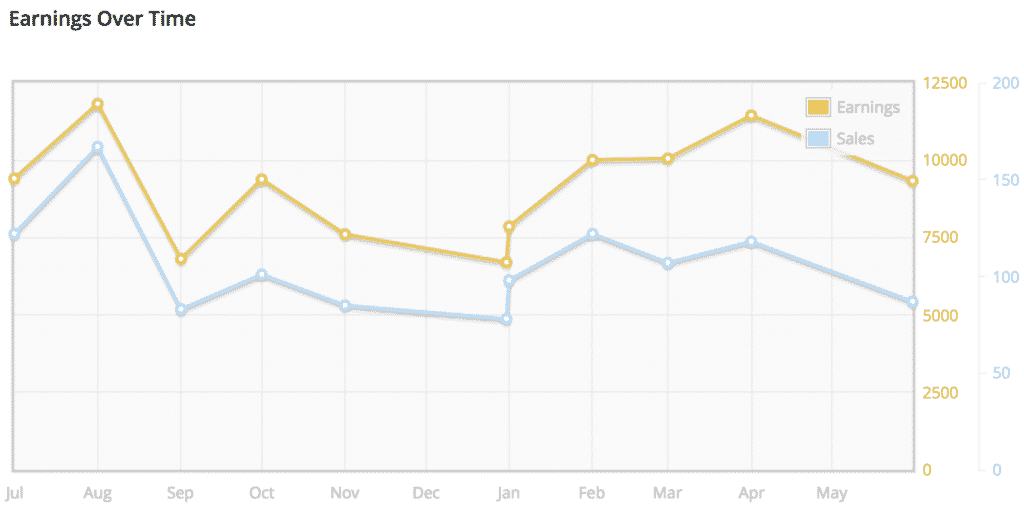GravityView went on sale July 24, 298 days ago. Yesterday, GravityView passed $100,000 in sales. I’d like to go over a few numbers and take a look back over the past 10 months and share some of what I’ve learned.
Here’s the $100,000 number broken down:
- $100,850 in sales
- 1,172 sales
- 66 refunds
- 32 affiliate referral sales (with $1,150 in payouts)

A chart of GravityView sales since launch.
The plugin’s been doing well: April was the second-best month yet after the launch month, and May is on track to be our best month ever.
Plugin support
We moved support desks in January, so the stats may be a bit inaccurate, but here they are:
- 1,323 resolved support requests
- 3,780 responses
- 98% happiness rating (from 105 rated replies)
- Average first response time: 16 minutes 47 seconds
- Average support resolution time: 11h 13m
- Average support requests per day: 6
- Busiest day: Tuesday (it is Floaty’s favorite day, after all!)
- Busiest time: 12-3pm Mountain
We’re working on improving our documentation and adding video tutorials. I hope this will help streamline our support process.
Code & Updates
We’ve been feverishly working on improving the plugin. Over the life of the project, we’ve released:
- 32 plugin updates
- 1,819 code commits from 6 contributors
- 7 Premium Extensions
- 1 Premium View
- 1 Premium plugin (Gravity Forms Entries Importer)
On making the code public
I made GravityView public on Github on February 18, 2015 (89 days ago) and I’m pleased to share that it did not slow down our sales, and has not led to more support requests.
- There have been a few Github users who requested support without a license, but it has been a non-issue overall.
- I know of at least two sales referred from Github, and there were two refunds processed because of the Github release. So that’s even.
Mistakes
- The first release version (1.1) had broken auto-update functionality. A couple more early releases also shared this flaw. D’oh!
- I chose to use a settings framework that caused more problems than it solved. In version 1.7, we switched to using Gravity Forms Addon Framework settings.
- Until a month after launch, I didn’t require customers register when checking out. This made it impossible for users to reach their Account page.
- During the launch period, I offered promotions for a 2-year license instead of a one year license. Instead, I should have offered a larger discount to improve cash flow this year.
- I didn’t handle the Github release well; I’m still nursing a blog article about it that would have been good to publish at the same time. Better communication would have provided answers to customers and helped promote the project.
- I should have scaled support earlier. Support is hard to do consistently; having more people working on tickets helps prevent burnout and allows development to move forward.
Successes
- Having Jonathan Mann create the GravityView song and video. It’s been an amazing marketing tool.
- Floaty has been a great mascot. Super cute!
- The pricing model has worked well. Keeping the Extensions bundled with the higher pricing tier has helped keep the average selling price high.
- The Easy Digital Downloads WordPress plugin has been a great shopping cart. It’s been…um…easy to sell digital downloads.
- Recently, Gustavo Bordoni joined the GravityView team. He’s working on development, support, and documentation, and I’m really happy to be working with him. Having Gustavo on board allows us to work on lots of new projects.
- Having an affiliate program has been really great. AffiliateWP is the best self-hosted affiliate software I’ve used.
- User-contributed translations have been easy. If you have a plugin, Transifex provides an easy way for users to contribute translations.
Improving the GravityView experience
There’s a ton of stuff we’re working on to improve code and functionality, but here are some things I want to tackle that will improve the overall experience of using GravityView:
- Onboarding process – Help users learn how to use GravityView better
- Provide sample data
- Send email tips on using GravityView
- Have instructional videos
- Informative blog posts – Show the usefulness of GravityView and the power of Gravity Forms through helpful articles.
- Website demos – The demos use placeholder content and don’t show great use cases for GravityView
- Customer communication – If customers aren’t using GravityView any more, why not? If they are, what can we improve? I need to get better at getting in touch with customers so we can better address their needs.
- Better developer communication – GravityView is on Github, but we’ve not had many pull requests or issues opened on Github. I would like to encourage more developer participation.
What a year.
I’m thrilled that GravityView is a successful product. I’m grateful for our customers, and am thankful for the work that Luis and Gustavo, and others have put into the plugin to make it a success.
Thanks to Gravity Forms for building a great plugin with a comprehensive API. There’s lots coming from them later this year—their roadmap is very friggin’ cool.
A special thanks to Pippin Williamson and Andrew Munroe for allowing me to fork their AffiliateWP website theme.
Thanks to Sarah Gooding at WPTavern, Bob Dunn, and Mark Zahra at WPMayor for covering GravityView on their sites.
Thank you to the WordPress community for being such an active and vibrant ecosystem. The WordPress platform is evolving (the REST API will be huge) and the web is shifting to native and mobile. There’s a ton of change, and that means lots of opportunity. I am excited about what’s next for WordPress, Gravity Forms and GravityView.
Thank you everyone for making it possible for me, Luis, and Gustavo to work on GravityView. Here’s to the next major milestone. ?
